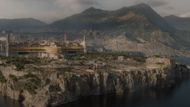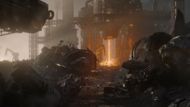Dune: Prophecy is a sci-fi series developed by Diane Ademu-John and Alison Schapker. The show is set within Frank Herbert’s Dune universe and is a prequel to the Denis Villeneuve movies. The show takes place around 10,000 years earlier than the movies.
Dune: Prophecy is inspired by but is set after the Great School of Dune novel trilogy by Brian Herbert and Kevin J. Anderson. The show focuses on the origins of the Bene Gesserit, the powerful social, religious, and political organization whose members have supernatural capabilities.
The show premiered in 2024 and has one season till now. With rave reviews from critics and viewers, Dune: Prophecy expands Frank Herbert’s world. In an interview with Variety, the show’s visual effects supervisors talk about how they were able to pull off complicated things like black snow and cracking ice during the season finale.
Details about how the Dune: Prophecy VFX artists created black snow and cracking ice

During the final episode of Dune: Prophecy, the character of Valya is trapped in a nightmare. She is on a frozen lake and has to struggle against winds and a blizzard to save her brother, Griffin, from drowning. In this scene, as Valya tries to save him and crawls across the lake, the black snow falls and ice starts to crack.
In an interview with Variety, visual effects producer Terron Pratt talks about transitioning between “the black and white snow.” He says,
“That black snow is an element of the virus component that we were seeing earlier when Sister Nazir is going through this moment where she’s trying to fight the virus. We’re seeing a visual representation of that virus in those hollow cubes where the virus is taking over. This is a further representation of that in a more substantial form.”
Therefore, the black snowflakes are the virus overtaking Valya and as she fights against it, the white flakes start to come.
“All of these components are part of the story and add a layer of detail,” Pratt adds.
On the other hand, visual effects supervisor Michael Enriquez talks about not letting the viewer know that a lot of effort is being spent on computer graphics. He wants it to look seamless. Enriquez states,
“If you’re pulled out, if you’re affected, we’re not doing our job”
Details about adding the fantastical elements in Dune: Prophecy

As the show is set in a futuristic society, the sci-fi elements play a huge role in the series.
“Things will feel different and look different. We can’t even imagine what that life will be like,” Pratt said. “But at the same time, we have to utilize effects that are grounded in reality so that the viewer can still understand what’s happening.”
Interestingly, production designer Tom Meyer decided on the look of the scenery in Dune: Prophecy and developed the environment. Thereafter, the VFX team could adjust the speed of the falling snow and the dark backdrop, which highlighted Valya’s struggles.
As Valya gets to Arrakis, the imagery shifts to the warm-colored sands and dunes of Arrakis. On this, Pratt says that,
“It wasn’t the story we were necessarily going to tell…We were going to cut to Valya’s vision of Desmond’s mind’s eye and visually, it was such incredible artwork that it just made sense to incorporate that into that last shot.”
The team worked closely with Image Engine VFX in Canada to help with the transition from the cool to the warm color palette.
Dune: Prophecy is available on HBO Max.
